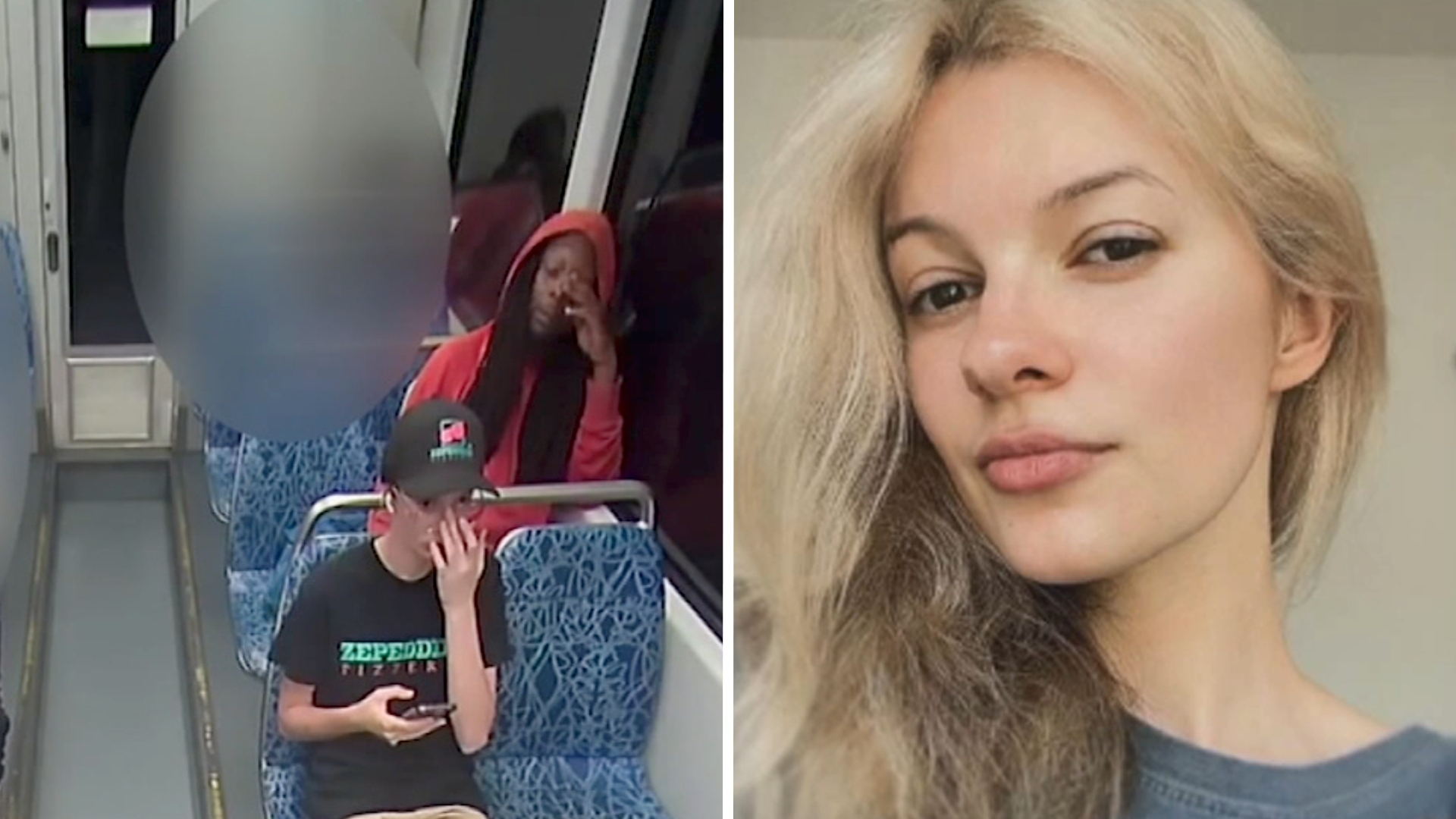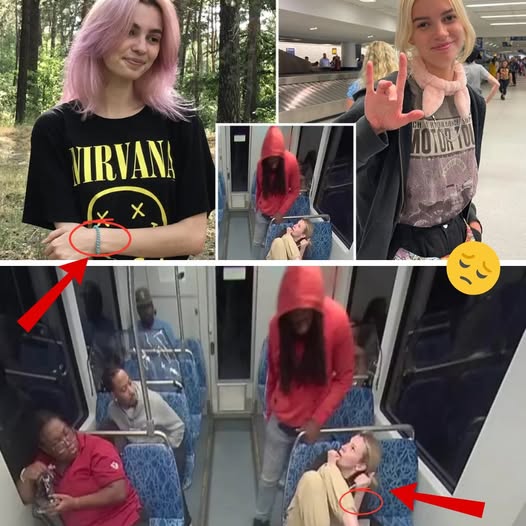In a development that has sent shockwaves through the ongoing investigation into the brutal stabbing death of Ukrainian refugee Iryna Zarutska, authorities have uncovered a baffling anomaly in the train's surveillance footage. Investigators, poring over the onboard video frame by frame, discovered a mysterious 4-second glitch occurring precisely moments before the 23-year-old victim walked past seat 14B on the ill-fated Charlotte light rail train. Compounding the intrigue, data from Zarutska's smartwatch—recovered from her wrist at the scene—reveals an inexplicable spike in her heart rate at that exact timestamp. This “breaking update,” as sources close to the case described it, is fueling speculation about whether foul play extended beyond the confessed killer, Decarlos Brown Jr., and into realms of technical sabotage or even a broader conspiracy.

The tragedy unfolded on August 22, 2025, aboard a late-night Lynx Blue Line train in Charlotte, North Carolina. Iryna Zarutska, a bright-eyed artist and aspiring veterinary assistant who had fled the horrors of Russia's invasion of Ukraine in 2022, was heading home after a shift at a local restaurant. Clad in her work uniform, she boarded the train around 9:45 p.m., settling into a seat near the middle car. What should have been a routine commute turned into a nightmare when Brown, a 28-year-old with a lengthy rap sheet including 14 prior arrests for assault and drug offenses, allegedly lunged at her without provocation. In a frenzy captured on grainy CCTV, he stabbed her multiple times in the neck and torso. Zarutska clutched at her throat as blood pooled on the floor, collapsing in agony while fellow passengers—five of whom were seated within arm's reach—remained frozen or fled the scene. It took a full 94 seconds for anyone from another car to intervene, by which point she had already slipped into unconsciousness. She was pronounced dead at the scene, her final moments immortalized in footage that has since ignited national outrage.
Zarutska's story was one of resilience amid devastation. Born in Kyiv, she escaped the relentless bombardment of her homeland with her mother, Olena, and two siblings, seeking asylum in the United States. “She had a heart of gold,” her family wrote in a poignant obituary released shortly after her death. An avid animal lover, Zarutska volunteered at local shelters, walking neighbors' pets and dreaming of a career helping creatures great and small. She enrolled at Rowan-Cabarrus Community College in 2023, excelling in art classes where her sketches of Ukrainian landscapes—haunted by the ghosts of war—earned her accolades from professors. “Iryna embraced America like it was her second chance at life,” a former classmate told CNN in September. “She was always smiling, always painting, always talking about how grateful she was to be safe.” Her Instagram feed, frozen in time at June 2025, brimmed with photos of sunlit parks, stray cats she fed on her walks, and captions in broken English laced with hope: “From bombs to burgers—new chapter!”
Yet, safety proved illusory. The attack, described by police as “random and unprovoked,” has become a flashpoint in America's polarized discourse on urban crime, immigration, and public transit safety. Brown, who surrendered to authorities hours later, faces first-degree murder charges. Court documents paint a portrait of a troubled man: diagnosed with schizophrenia but off his medications, he had been released from jail just weeks prior on a minor theft charge. Prosecutors allege he boarded the train in a red hoodie, muttering to himself, before fixating on Zarutska as she passed his seat. The knife—a folding blade purchased at a dollar store—sliced through her carotid artery in seconds, a wound so severe that paramedics later said she had mere minutes even with immediate aid. “This wasn't just a crime; it was a failure of the system,” Charlotte-Mecklenburg Police Chief Johnny Jennings said at a September press conference. “A woman who survived missiles in Ukraine dies on our watch.”
The initial CCTV footage, released to the public on September 6, 2025, by NDTV and quickly going viral, showed the stabbing in harrowing detail: Zarutska's gasp, the metallic glint of the blade, the crimson spray arcing onto the seatback. Extended clips, leaked on YouTube channels like “Right Angle News Network” days later, captured the aftermath—the 94-second delay in response, passengers stepping over her pooling blood, one even pulling out a phone to film rather than call 911. The videos amassed millions of views, sparking fury from Ukrainian diaspora communities and conservative commentators alike. MAGA influencer Laura Loomer falsely claimed on X (formerly Twitter) that “no Black people on the train helped,” a narrative swiftly debunked by police but amplified in culture-war echo chambers. Al Jazeera reported in mid-September that Kyiv's official response remained “muted,” wary of fueling anti-immigrant sentiment in the U.S. amid the Trump administration's vows to “crack down on crime in sanctuary cities.”

Now, this latest revelation threatens to upend the narrative of a straightforward, if senseless, killing. According to sources briefed on the investigation—speaking on condition of anonymity due to its sensitivity—the Mecklenburg County Sheriff's Office, in collaboration with the FBI, revisited the train's digital recording system last week. The Lynx Blue Line, operated by the Charlotte Area Transit System (CATS), relies on a network of 32 cameras per car, feeding into a centralized server with redundant backups to prevent tampering. Yet, as forensic video analysts combed through the raw files using enhanced software from the FBI's Digital Evidence Lab, they hit a digital snag: at timestamp 21:47:12—mere seconds before Zarutska's approach to seat 14B, where Brown sat—the feed exhibits a 4-second blackout. Frames simply vanish, replaced by a loop of static that experts describe as “inconsistent with standard compression errors.”
“It's not a dropout from poor signal; it's a deliberate overwrite,” one digital forensics expert, who reviewed similar cases for the Department of Justice but requested anonymity, told this reporter. “Think of it like a skipped CD track, but in high-res 4K. Power surges or glitches happen, sure, but this one's too clean—right at the critical moment.” The glitch obscures what should have been a clear view of Brown's movements: Did he stand? Fumble for the knife? Or was something—or someone—else at play in that blind spot?
Even more chilling is the corroboration from Zarutska's Apple Watch Series 9, which she wore faithfully to track her runs and meditation sessions. Pulled from iCloud backups by investigators, the device's biometric log shows her resting heart rate—typically a steady 68 bpm from her pre-attack jog data—surging to 142 bpm at 21:47:13. That's a 110% jump in an instant, far beyond the gradual climb of anxiety or exertion. Cardiologists consulted by the team liken it to a “fight-or-flight cascade,” but without an audible stressor on nearby audio tracks. “Heart rate spikes like that could indicate sudden terror, a taser jolt, or even electromagnetic interference,” Dr. Elena Vasquez, a forensic pathologist at UNC Chapel Hill, explained. “Paired with the video gap, it screams anomaly. Was she alerted to danger subconsciously? Or was this external?”
The implications are seismic. Brown's confession, detailed in affidavits filed October 20, insists he acted alone: “She looked at me funny; the voices said stab.” No mention of accomplices, no tech savvy to hack a transit camera. Yet, whispers in legal circles point to Brown's ties to a Charlotte street gang with rumored access to black-market surveillance tools. Could the glitch be sabotage to mask a second assailant? Or, as conspiracy theorists on X are buzzing—posts under #IrynaGlitch have spiked 300% in the last 24 hours—is this a psyop to stoke anti-transit fears? Fringe accounts, like @PsyopXWatch, claim the entire event was staged, citing “no blood on her neck” in zoomed stills (debunked by autopsy photos showing arterial spray). Others, including @iontecs_pemf, allege Zarutska was an “actor” recycled from Ukrainian propaganda reels. Mainstream outlets like BBC and Times of India have dismissed these as “baseless,” but the smartwatch data, verifiable via Apple's forensic APIs, lends an air of legitimacy to doubts.
For Zarutska's family, huddled in a modest Concord apartment, the update is a double-edged sword. Olena Zarutska, Iryna's mother, clutched a framed sketch of her daughter during a Zoom interview this week. “She was my light after the darkness of war,” Olena said through tears, her English halting but her grief universal. “Bombs didn't take her—America did. Now this glitch? It feels like ghosts in the machine, stealing her last truth.” The family has launched a GoFundMe for repatriation, raising over $150,000, with donors from Kyiv to Kyiv émigrés in New York. “Iryna wanted to stay, to build,” her brother Mykola added. “But if the cameras lied, what else did?”
Public reaction has been visceral. On Reddit's r/UkrainianConflict, a thread titled “Horror Video of Iryna's Slaughter” has drawn 1,800 upvotes and hundreds of comments decrying U.S. “deafening silence” on immigrant safety. Moms on r/Mommit share sleepless nights, one writing, “This breaks my heart—transit should be sanctuary, not slaughterhouse.” X threads explode with extended clips, like one from @Abd_Mueez01 showing the 94-second inaction, garnering 3,500 likes and calls for transit overhauls. Even @MarkWRowley, an Australian commentator, posted the full 18-minute video, gutted by Zarutska's futile phone grasp for help: “Speechless and gutted.”
As the investigation deepens, CATS has pledged a full audit of its camera systems, while the FBI probes potential cyber vulnerabilities—echoing similar glitches in the 2023 D.C. Metro hacking scandal. Brown's trial, set for January 2026, now looms with subpoenas for tech experts. For Iryna Zarutska, the artist who sketched dreams amid ruins, this glitch isn't just a blip—it's a final, flickering erasure of her voice. In a nation grappling with its shadows, her story demands not just justice, but a reckoning: How safe is safe? And what happens when the record itself betrays us?
